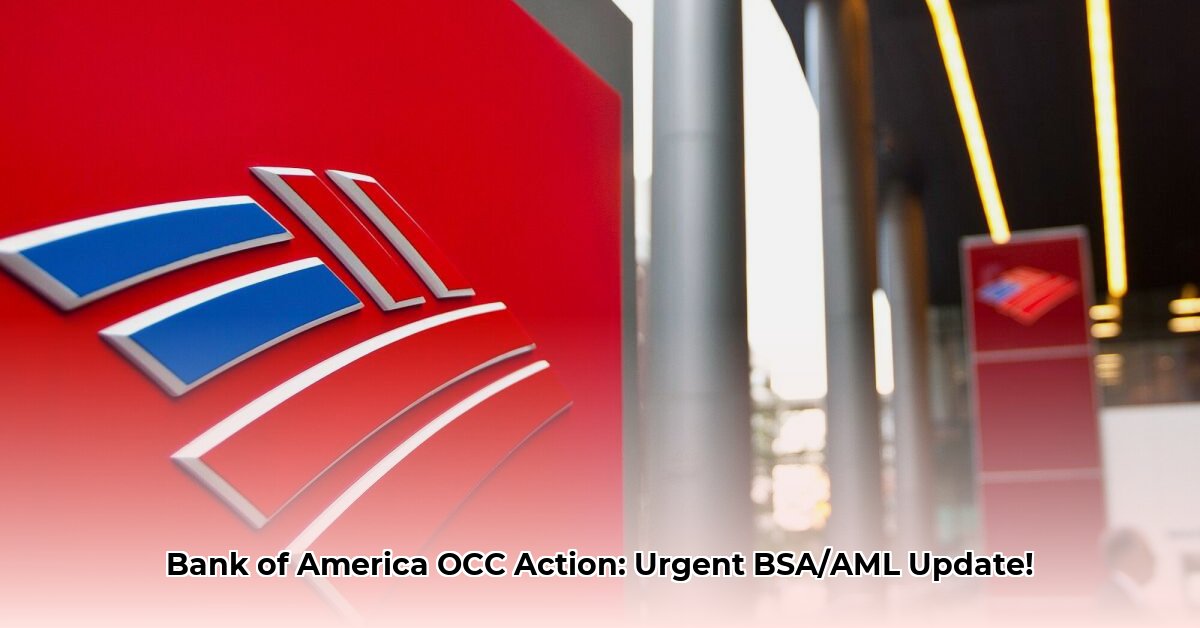
Bank of America OCC Enforcement: A Critical Review of BSA/AML Compliance
The Office of the Comptroller of the Currency (OCC) enforcement actions against Bank of America serve as a stark reminder of the crucial need for robust Bank Secrecy Act (BSA) and Anti-Money Laundering (AML) compliance programs within the financial industry. This guide provides actionable insights and a practical framework for strengthening your institution's defenses against regulatory scrutiny and illicit financial activities. We will analyze the key findings of the OCC investigation, assess associated risks, and offer a step-by-step plan to improve your BSA/AML compliance posture. The implications of non-compliance are significant, impacting not only your financial stability but also your reputation and long-term sustainability.
Key Findings: Systemic Weaknesses in Bank of America's BSA/AML Program
The OCC's investigation revealed systemic weaknesses across Bank of America's BSA/AML program, highlighting several critical areas for improvement:
- Delays in Suspicious Activity Report (SAR) Filing: Significant delays in filing SARs hampered investigations and demonstrated a systemic lack of timely reporting of potentially suspicious activities.
- Inadequate Customer Due Diligence (CDD): Insufficient CDD processes allowed potentially high-risk individuals and entities to open accounts and conduct transactions without adequate scrutiny.
- Weak Internal Controls and Oversight: A lack of robust internal controls and effective oversight mechanisms allowed compliance failures to persist without timely detection or remediation.
- Insufficient Employee Training: Inadequate training on BSA/AML regulations and procedures resulted in a lack of understanding and awareness among employees responsible for compliance.
These findings underscore the interconnectedness of different components within a comprehensive BSA/AML compliance framework. Weaknesses in one area can cascade and amplify vulnerabilities in others.
Risk Assessment and Mitigation: A Layered Approach to Compliance
The risk associated with insufficient BSA/AML compliance is considerable, potentially leading to substantial fines, reputational damage, and legal repercussions. A layered approach to risk mitigation is essential.
| Area of Risk | Risk Level | Mitigation Strategies | Example Implementations |
|---|---|---|---|
| SAR Filing Delays | Very High | Implement automated SAR filing systems, establish clear escalation protocols for suspicious activity, and conduct regular audits of SAR filing processes. | Invest in specialized SAR software; integrate SAR filing into transaction monitoring systems; conduct regular simulated SAR filing exercises. |
| Inadequate Customer Due Diligence | High | Enhance CDD procedures through improved KYC (Know Your Customer) processes, employ advanced screening tools to identify high-risk individuals, and strengthen identity verification. | Utilize AI-powered KYC platforms; implement enhanced due diligence (EDD) protocols for high-risk customers; regularly review and update customer risk profiles. |
| Weak Internal Controls | Very High | Establish a robust framework of internal controls with clearly defined roles and responsibilities, conduct regular internal audits, and implement a strong corporate governance structure. | Implement a comprehensive compliance management system; integrate risk assessment into daily operations; conduct regular independent audits of compliance processes. |
| Insufficient Employee Training | Medium | Provide comprehensive and ongoing BSA/AML training, incorporating real-world scenarios and interactive modules. Ensure regular updates to reflect evolving regulatory changes. | Implement a comprehensive training program using a blended learning approach (online modules, in-person workshops); conduct regular refresher courses; utilize gamification techniques. |
| Technology Gaps | Medium | Evaluate and implement appropriate RegTech solutions to enhance transaction monitoring, improve data analysis, and streamline compliance processes. | Integrate AI-powered transaction monitoring tools; utilize data analytics to identify patterns; implement automated alert and escalation systems. |
Actionable Steps: A Practical Guide for Improving BSA/AML Compliance
This section offers practical steps for various stakeholders to enhance their BSA/AML compliance programs.
1. For Financial Institutions:
- Conduct a thorough gap analysis of your existing BSA/AML program against regulatory requirements and best practices.
- Invest in advanced technology to streamline processes, enhance monitoring capabilities, and improve the efficiency of data analysis.
- Implement a comprehensive compliance training program that addresses all levels of employees and keeps pace with evolving regulatory changes.
- Establish a robust system for internal audits and reporting, ensuring continuous monitoring and prompt remediation of identified deficiencies.
2. For Regulators:
- Enhance communication and collaboration among regulatory bodies to ensure consistent application of BSA/AML standards.
- Provide clearer and more accessible guidance to financial institutions on compliance expectations.
- Leverage technology to improve supervisory efficiency and enhance the detection of compliance failures.
3. For Independent Consultants:
- Stay current on the latest regulatory developments and best practices in BSA/AML compliance.
- Develop sophisticated methodologies and tools for conducting risk assessments and gap analyses.
- Offer targeted training programs that address the specific needs of financial institutions.
Regulatory Implications and Reputational Risk: The High Cost of Non-Compliance
Non-compliance with BSA/AML regulations carries severe consequences, including substantial financial penalties, reputational damage, operational disruptions, and potential criminal charges. The Bank of America case underscores the critical importance of proactive and comprehensive compliance programs. The financial and reputational costs of non-compliance far outweigh the investment in a robust and effective BSA/AML framework.
"The consequences of BSA/AML non-compliance are severe, impacting an institution’s financial stability, reputation and long-term prospects," says Dr. Anya Sharma, Compliance Expert, Regulatory Solutions Group.
The proactive adoption of this guide’s recommendations is crucial for mitigating risks, ensuring regulatory compliance, and protecting your institution's reputation and long-term stability. The potential for financial penalties, lasting reputational damage, and even criminal charges associated with non-compliance underscores the imperative for immediate and decisive action.